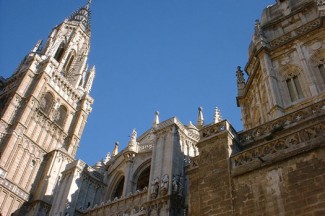 For Americans, visiting Europe has been a rite of passage since well before even Mark Twain’s Innocents Abroad. And given the number of significant old cathedrals on the continent, Eurotours inevitably include churches we visit more as museums than as places of faith.
For Americans, visiting Europe has been a rite of passage since well before even Mark Twain’s Innocents Abroad. And given the number of significant old cathedrals on the continent, Eurotours inevitably include churches we visit more as museums than as places of faith.
Ten years ago, I found myself on such a tour in Toledo, Spain. At Toledo’s very center is an enormous cathedral that was once a true seat of power for the Catholic Church. Begun in 1227, it took 250 years to finish this temple of Spain’s establishment religion.
I read about it in James Michener’s 795-page Iberia and went to visit with the book in hand. I went in part as a tourist, but also as an actual (if slightly disenchanted) twentysomething Catholic.
Walking in, I felt the Spanish sunlight immediately shut off behind me. The ceiling loomed nearly 150 feet above. The far wall stretched almost 500 feet away.
The space intimidated. Its massive size figured in, but so did its contents: joyless Christian iconography, battle and conquest depictions, and marble tombs. I kneeled in a pew but found I couldn’t pray.
I grappled with my knowledge of the long-ago Inquisition and my all-too-recent sobering experience in the cathedral. How could I reconcile the Church I’d grown up with, loved and wanted to continue believing in with some of its less savory (and even hypocritical) history?
Michener called the place a masterpiece of concept and execution. I, on the other hand, was totally thrown. To my eyes, the Toledo cathedral wasn’t so much beautiful as showy. Despite my efforts to appreciate its history, it seemed clear to me that the artwork and architecture were more about displaying power than honoring God.
Knowing even a little about the Spanish Inquisition made that even more abundantly clear. Banning great works of literature was the least of the power-tripping that went on. Centuries of sham trials and executions were overseen by the royal family and its Church representatives. Thousands were tortured, most often on the rack, and many burned at the stake, all in the name of faith.
Michener used terms like noble, tasteful, rich, beautiful and rewarding to describe various aspects of the cathedral. Yet for me, the more ostentatious artifacts and chapels I saw, the more turned off I became.
I grappled with my knowledge of the long-ago Inquisition and my all-too-recent sobering experience in the cathedral. How could I reconcile the Church I’d grown up with, loved and wanted to continue believing in with some of its less savory (and even hypocritical) history?
The conclusion I ultimately came to was that the Catholic Church is a human institution — and since we humans by nature are flawed, so are all of our institutions. This is even true for institutions with high ideals, like churches. In fact, the higher the ideals, the more disillusioning the disappointment when the institution fails (as it inevitably will) to live up to them.
Our nations haven’t always done the right thing, either. The United States hasn’t always lived out its own declaration that all men and women are created equal; it allowed slavery and segregation for centuries. Yet it is still good for a citizen to be patriotic, to believe we will continue progressing toward our ideals. The best response is to learn and accept the history of the institution — then work to make it better.
The decade since that vacation visit to the Toledo cathedral hasn’t made it any easier to remain a faithful Catholic. In fact, tragic failings like the priest sex abuse scandal have made it even harder.
I could leave in search of another, probably smaller, church and hope it would be blameless. And maybe with a shorter history, it could manage to have demonstrated fewer failings. But since all of our institutions — from churches to countries to clubs to schools — are human, they are all flawed. In a search for perfection, I’d soon find myself searching again.
I expected my vacation to Spain to include interesting sightseeing and maybe even some kinship as a Catholic in a Catholic country. Instead, it left me grappling with a sometimes ugly history. But by being shaken, my faith has only been examined — and strengthened.




